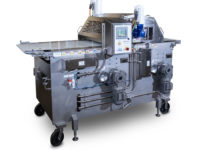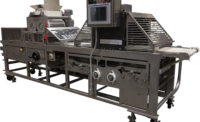Automation, advances in sanitary design, greater worker safety and additional flexibility in packaging have been among the top requests that manufacturers of cutting, slicing and portioning equipment say they’ve been fielding from their customers this year.
Top priorities
Labor savings has been top of mind for customers of FoodTools, South Haven, MI, according to Doug Petrovich, executive vice president. “That’s what everybody is looking for, because it’s getting difficult to find people to work—let alone high-quality people—because the economy is strong. The more automation you can supply, the more labor you’re going to save. Automation is definitely an important part of our business right now.”
Sanitation comes in a close second, Petrovich says. “Everybody is really keen on sanitation for liability purposes. In the food business, we’ve got to keep the machine clean. The product, for the most part, has gone through the ‘kill zone,’ which is the oven, but there’s always a possibility of contamination.”
Sanitary design is also high on the list of customers at Urschel, Chesterton, IN, says Mike Jacko, vice president of applications and new product innovation—in part that’s because of more intensive government inspections under the Food Safety Modernization Act (FSMA), he says.
“Many more customer plants are getting dinged by these inspectors to the point where they’re scrambling, trying to figure out a way to clean machines and plants,” Jacko says. “We are seeing some folks coming back to us asking if there are some things that can be done to make machines easier to clean than they are right now.”
Worker safety is another issue that comes up regularly. “All machines that cut something have to have knives in them,” says Jacko. “Keeping a customer safe so they don’t cut off a finger is extremely important.”
LeMatic Inc. and Citamel Packaging, Jackson, MI, have seen greater numbers of requests to pillow-pack smaller quantities of items, says Trevor Wilcox, sales executive, U.S. market. For example, McDonald’s Corp. asked to compartmentalize three packages with 10 buns each where it previously had been satisfied with a single package of 30.
“Some customers have asked us to separate the package completely, which we can do through a cutter,” says Wilcox. “Some people have asked us to perforate the package. They’re constantly asking us to make it as user-friendly as possible.”
Off the line
Manufacturers have been rolling out a variety of new, updated and custom slicing, cutting and portioning equipment to meet these requests and others.
Reiser, Canton, MA, offers the Vemag Dough Portioner, which can handle all types of doughs, batters and fillings for snack and bakery products by incorporating various Reiser-engineered attachments that can be swapped in and out in minutes. The unit’s servo technology provides high levels of portioning accuracy, production efficiency, versatility and product quality, says John McIsaac, vice president of strategic business development.
Coupled with the appropriate attachment, the Vemag can be used, in single or multiple lanes, as a dough divider for breads, rolls, buns and English muffins, or as a cookie dough or cake batter depositor, a brownie sheeter or a bar extruder, McIsaac says. The machine has a positive-displacement double-screw pump that produces accurate portions and gentle transport without crushing or smearing.
Reiser also has rolled out the Vemag Process Check weigher for portioning accuracy, ideal for dough given the critical importance of consistently accurate weights. The Process Check communicates directly the Dough Portioner to fine-tune each portion, based on factors like temperature and density, with no operator intervention. The machine also providers verification and tracking data for the bakery, adds McIsaac.
FoodTools has shipped a number of custom machines around the globe in recent months. The Accusonic 200RS inline high-speed ultrasonic round cake cutter, sent to the U.K., has a full-wave blade that cuts around taller-than-normal products and cuts two cakes simultaneously to increase throughput, Petrovich says. “We’ve developed a clamping system that allows us to hold the product better and achieve more-equal portions.”
The Accusonic 200FS full-sheet ultrasonic cutter just shipped to China. Providing the capability of cutting both round and full sheets, with two separate cutting stations, the machine can create triangles and wedges in addition to round products, Petrovich says. And the company has also sent an Accuslice 100 LS loaf slicer to Australia. Designed to cut up to eight loaves of banana bread or pound cake, like those available at Starbucks, the Accuslice drops those slices onto a right-angle conveyor that feeds an individually wrapped system.
Reiser is also in the process of building an Accuslice 300 RF roll-feeding machine for slicing round cakes, which will be shipped to Colorado soon. “It’s going to be a mechanical slicing machine, with a stainless steel blade rather than ultrasonic,” says Petrovich. “It also feeds divider inserts in between slices.”
LeMatic primarily builds custom equipment that handles buns and rolls, but also has fielded requests for machines to portion doughnuts and to slice a waffle in half, Wilcox says. On certain lines, the company has added a BF15 band slicer head with an automatic height adjustment for the blade. “When they change from product to product, each will have a set slide height limit on it,” he says.
The company also has handled requests for gluten-free products and for bakery items with inclusions such as raisins, or cinnamon, or sugar, which adds challenges. “We’ve got to take that into consideration,” Wilcox says. “We need to make sure we can hold it in place as it passes through the slicer.”
Customers also have asked LeMatic to slice products that are above usual limits for heat and below usual limits for cold. “That throws challenges in there,” says Wilcox. “It really makes us take a look at how we have set up the slicers, and the whole line, for that matter. There’s a certain limit we have to consider that’s going to be comfortable for us. If it’s too hot going through the blade, and it’s getting hung up, or not slicing properly, we’re going to have to work around it somehow. The same goes for if it’s too cold.”
For snack processing, Urschel is currently testing an updated take on its venerable Model CC Slicer for potato chips and other salty snacks, Jacko says. “We’re making it from scratch,” he says. “It’s for taking the potato and peeling it into potato chips.”
Other Urschel machines take scraps from snack and bakery products and recycle them for alternate uses—like OREO cookies used as crumbles on a Dairy Queen Blizzard, for example, Jacko says. “They’ll re-grind an entire cookie with our machine,” he says. “People are trying to do higher capacity for these inclusion products.”























